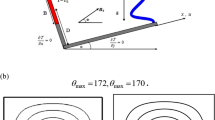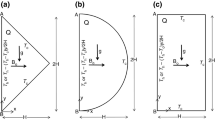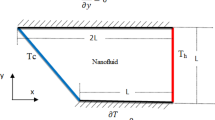Abstract
The aim of the current study is natural convection analysis conjugated with entropy generation analysis in an incinerator shaped permeable enclosure loaded with Al2O3–H2O nanofluid subjected to the magnetic field with a rectangular wavy heater block positioned on the bottom of the cavity wall. The bottom and top horizontal walls are adiabatic; the inclined and vertical walls are thought to be cooled. Firstly, the governing expressions and standard k–ε turbulence model are rewritten from dimensional form to non-dimensional form using dimensionless parameters such as vorticity and stream function. In the next step, the equation of entropy generation is written in dimensionless form. Then, the system of non-dimensional governing equations is solved by the finite volume method (FVM) conjugated with a non-dimensionalization scheme using ANSYS Fluent. Fine grids (wall y+ < 2) with inflated layers have been used for the higher Rayleigh number. The effects of the Rayleigh number in the laminar region (Ra = 103, 104, and 105) and turbulent region (Ra = 108, 0.5 × 109, and 109), Darcy number (Da = 0.01 and 100), Hartmann number (Ha = 0 and 40), and the nanoparticles (\( \phi = 2{{\% }} \)) on the entropy generation number and natural convection are investigated. The validation results were in good agreement with those of the literature. The results demonstrate that for the laminar region, the Nusselt number and entropy generation number increase as the Rayleigh number and the Darcy number grow, whereas both of them abate as Hartmann number increases. In the turbulent region, the average Nusselt number decreases by ascending the Darcy number. Also, for turbulent region (Ra = 109), convection flow strength decreases 6.28% when Hartmann number increases from 0 to 40, whereas the entropy generation number increases 31.5% at Da = 0.01.








Similar content being viewed by others
Abbreviations
- B 0 :
-
Magnetic field strength
- B :
-
Magnetic field (T)
- Be:
-
Bejan number
- C p :
-
Specific heat capacity (J kg−1 K−1)
- E:
-
Dimensionless dissipation rate of turbulent kinetic energy
- g :
-
Gravitational acceleration (m s−2)
- Ha:
-
Hartmann number
- k :
-
Dimensional turbulent kinetic energy (m2 s−2)
- \(\tilde{k}\) :
-
Thermal conductivity (W m−1 K−1)
- K:
-
Dimensionless turbulent kinetic energy
- K P :
-
Permeability of the medium (m2)
- L :
-
Length of the cavity (m)
- m :
-
Shape factor of nanoparticles
- N:
-
Entropy generation number
- Nu:
-
Nusselt number
- p :
-
Pressure (N m−2)
- Pr:
-
Prandtl number (–)
- Ra:
-
Rayleigh number
- \(\dot{S}_{\text{gen}}\) :
-
Rate of entropy generation per unit volume (J s−1 K−1 m−3)
- T :
-
Temperature (K)
- u, v :
-
Dimensional x and y components of velocity (m s−1)
- x, y :
-
Dimensional coordinates (m)
- X, Y:
-
Dimensionless coordinates
- α :
-
Thermal diffusivity (m2 s−1)
- β :
-
Thermal expansion coefficient (K−1)
- ɛ :
-
Turbulent dissipation of kinetic energy (m2 s−3)
- \({{\Theta}}\) :
-
Dimensionless temperature (–)
- λ :
-
Inclination angle (°)
- μ :
-
Dynamic viscosity (N s m−2)
- ν :
-
Kinematic viscosity (m2 s−1)
- ρ :
-
Density (kg m−3)
- σ :
-
Electrical conductivity (Ω m−1)
- \(\sigma_{\text{k}}\) :
-
\({k} - {\varepsilon}\) Turbulent model parameters
- φ :
-
Cavity inclination angle (°)
- ΔT :
-
Temperature difference
- ϕ :
-
Volume fraction
- \({{\Phi}}\) :
-
Irreversibility distribution ratio
- ψ :
-
Dimensional stream function (m2 s−1)
- \({{\Psi }}\) :
-
Dimensionless stream function
- ω :
-
Dimensional vorticity (s−1)
- \({{\Omega }}\) :
-
Dimensionless vorticity
- ave:
-
Average
- FF:
-
Fluid friction
- gen:
-
Generation
- h:
-
Hot
- HT:
-
Heat transfer
- MF:
-
Magnetic field
- nf:
-
Nanofluid
- PM:
-
Porous medium
- s:
-
Solid
- t:
-
Turbulent
References
Gholamalipour P, Siavashi M, Doranehgard MH. Eccentricity effects of heat source inside a porous annulus on the natural convection heat transfer and entropy generation of Cu–water nanofluid. Int Commun Heat Mass Transf. 2019;109:104367.
Siavashi M, Yousofvand R, Rezanejad S. Nanofluid and porous fins effect on natural convection and entropy generation of flow inside a cavity. Adv Powder Technol. 2018;29(1):142–56.
Seyyedi SM, Sahebi N, Dogonchi AS, Hashemi-Tilehnoee M. Numerical and experimental analysis of a rectangular single-phase natural circulation loop with asymmetric heater position. Int J Heat Mass Transf. 2019;130:1343–57.
Dogonchi AS, Waqas M, Gulzar MM, Hashemi-Tilehnoee M, Seyyedi SM, Ganji DD. Simulation of Fe3O4–H2O nanoliquid in a triangular enclosure subjected to Cattaneo–Christov theory of heat conduction. Int J Numer Methods Heat Fluid Flow. 2019;29(11):4430–44. https://doi.org/10.1108/HFF-01-2019-0031.
Maghsoudi P, Siavashi M. Application of nanofluid and optimization of pore size arrangement of heterogeneous porous media to enhance mixed convection inside a two-sided lid-driven cavity. J Therm Anal Calorim. 2019;135(2):947–61.
Siavashi M, Ghasemi K, Yousofvand R, Derakhshan S. Computational analysis of SWCNH nanofluid-based direct absorption solar collector with a metal sheet. Sol Energy. 2018;170:252–62.
Xiong Q, Abohamzeh E, Ali JA, Hamad SM, Tlili I, Shafee A, Habibeh H, Nguyen TK. Influences of nanoparticles with various shapes on MHD flow inside wavy porous space in appearance of radiation. J Mol Liq. 2019;292:111386.
Abbassi MA, Safaei MR, Djebali R, Guedri K, Zeghmati B, Alrashed AA. LBM simulation of free convection in a nanofluid filled incinerator containing a hot block. Int J Mech Sci. 2018;144:172–85.
Seyyedi SM, Dogonchi AS, Ganji DD, Hashemi-Tilehnoee M. Entropy generation in a nanofluid-filled semi-annulus cavity by considering the shape of nanoparticles. J Therm Anal Calorim. 2019;138(2):1607–21.
Seyyedi SM, Dogonchi AS, Hashemi-Tilehnoee M, Asghar Z, Waqas M, Ganji DD. A computational framework for natural convective hydromagnetic flow via inclined cavity: an analysis subjected to entropy generation. J Mol Liq. 2019;287:110863.
Zeeshan A, Shehzad N, Abbas T, Ellahi R. Effects of radiative electro-magnetohydrodynamics diminishing internal energy of pressure-driven flow of titanium dioxide-water nanofluid due to entropy generation. Entropy. 2019;21(3):236.
Alamri SZ, Khan AA, Azeez M, Ellahi R. Effects of mass transfer on MHD second grade fluid towards stretching cylinder: a novel perspective of Cattaneo–Christov heat flux model. Phys Lett A. 2019;383(2–3):276–81.
Hassan M, Ellahi R, Bhatti MM, Zeeshan A. A comparative study on magnetic and non-magnetic particles in nanofluid propagating over a wedge. Can J Phys. 2018;97(3):277–85.
Ellahi R, Sait SM, Shehzad N, Mobin N. Numerical simulation and mathematical modeling of electro-osmotic Couette–Poiseuille flow of MHD power-law nanofluid with entropy generation. Symmetry. 2019;11(8):1038.
Sarafraz MM, Pourmehran O, Yang B, Arjomandi M, Ellahi R. Pool boiling heat transfer characteristics of iron oxide nano-suspension under constant magnetic field. Int J Therm Sci. 2020;147:106131.
Yousif MA, Ismael HF, Abbas T, Ellahi R. Numerical study of momentum and heat transfer of MHD Carreau nanofluid over an exponentially stretched plate with internal heat source/sink and radiation. Heat Transf Res. 2019;50(7):649–58.
Izadi A, Siavashi M, Xiong Q. Impingement jet hydrogen, air and CuH2O nanofluid cooling of a hot surface covered by porous media with non-uniform input jet velocity. Int J Hydrog Energy. 2019;44(30):15933–48.
Siavashi M, Karimi K, Xiong Q, Doranehgard MH. Numerical analysis of mixed convection of two-phase non-Newtonian nanofluid flow inside a partially porous square enclosure with a rotating cylinder. J Therm Anal Calorim. 2019;137(1):267–87.
Siavashi M, Joibary SM. Numerical performance analysis of a counter-flow double-pipe heat exchanger with using nanofluid and both sides partly filled with porous media. J Therm Anal Calorim. 2019;135(2):1595–610.
Ghasemi K, Siavashi M. Three-dimensional analysis of magnetohydrodynamic transverse mixed convection of nanofluid inside a lid-driven enclosure using MRT-LBM. Int J Mech Sci. 2020;165:105199.
Bozorg MV, Siavashi M. Two-phase mixed convection heat transfer and entropy generation analysis of a non-Newtonian nanofluid inside a cavity with internal rotating heater and cooler. Int J Mech Sci. 2019;151:842–57.
Miroshnichenko IV, Sheremet MA. Turbulent natural convection heat transfer in rectangular enclosures using experimental and numerical approaches: a review. Renew Sustain Energy Rev. 2018;82:40–59.
Vasiliev A, Sukhanovskii A, Frick P, Budnikov A, Fomichev V, Bolshukhin M, Romanov R. High Rayleigh number convection in a cubic cell with adiabatic sidewalls. Int J Heat Mass Transf. 2016;102:201–12.
Pop I, Sheremet MA. Turbulent natural convection combined with entropy generation in a nanofluid cavity with non-uniformly heated side walls. J Phys Conf Ser. 2019;1366(1):012049.
Barakos G, Mitsoulis E, Assimacopoulos D. Natural convection flow in a square cavity revisited: laminar and turbulent models with wall functions. Int J Numer Methods Fluids. 1994;18(7):695–719.
Miroshnichenko IV, Sheremet MA. Turbulent natural convection combined with thermal surface radiation inside an inclined cavity having local heater. Int J Therm Sci. 2018;124:122–30.
Miroshnichenko I, Sheremet M, Chamkha AJ. Turbulent natural convection combined with surface thermal radiation in a square cavity with local heater. Int J Numer Methods Heat Fluid Flow. 2018;28(7):1698–715.
Saleh H, Roslan R, Hashim I. Natural convection heat transfer in a nanofluid-filled trapezoidal enclosure. Int J Heat Mass Transf. 2011;54(1–3):194–201.
Wang XQ, Mujumdar AS. Heat transfer characteristics of nanofluids: a review. Int J Therm Sci. 2007;46(1):1–9.
Dogonchi AS, Ismael MA, Chamkha AJ, Ganji DD. Numerical analysis of natural convection of Cu–water nanofluid filling triangular cavity with semicircular bottom wall. J Therm Anal Calorim. 2019;135(6):3485–97.
Abu-Nada E, Masoud Z, Hijazi A. Natural convection heat transfer enhancement in horizontal concentric annuli using nanofluids. Int Commun Heat Mass Transf. 2008;35(5):657–65.
Dogonchi AS, Waqas M, Seyyedi SM, Hashemi-Tilehnoee M, Ganji DD. CVFEM analysis for Fe3O4–H2O nanofluid in an annulus subject to thermal radiation. Int J Heat Mass Transf. 2019;132:473–83.
Dincer I, Rosen MA. Eergy, energy, environment and sustainable development. Amsterdam: Elsevier Publishing; 2007.
Woods LC. The thermodynamics of fluid systems. Oxford: Oxford University Press; 1975.
Magherbi M, Abbassi H, Brahim AB. Entropy generation at the onset of natural convection. Int J Heat Mass Transf. 2003;46(18):3441–50.
Hashemi-Tilehnoee M, Sahebi N, Dogonchi AS, Seyyedi SM, Tashakor S. Simulation of the dynamic behavior of a rectangular single-phase natural circulation vertical loop with asymmetric heater. Int J Heat Mass Transf. 2019;139:974–81.
Hashemi-Tilehnoee M, Tashakor S, Seyyedi SM, Sahebi N. Forced reflood modeling in a 2 × 2 rod bundle with a 90% partially blocked region. Ann Nucl Energy. 2019;131:425–32.
Karami M, Tashakor S, Afsari A, Hashemi-Tilehnoee M. Effect of the baffle on the performance of a micro pin fin heat sink. Therm Sci Eng Progr. 2019;14:100417.
Paroncini M, Corvaro F. Natural convection in a square enclosure with a hot source. Int J Therm Sci. 2009;48(9):1683–95.
Abbassi MA, Djebali R, Guedri K. Effects of heater dimensions on nanofluid natural convection in a heated incinerator shaped cavity containing a heated block. J Therm Eng. 2018;3:2018–36.
Acknowledgements
This work has been supported by a research contract of the Islamic Azad University, Aliabad Katoul Branch, Iran.
Author information
Authors and Affiliations
Corresponding author
Additional information
Publisher's Note
Springer Nature remains neutral with regard to jurisdictional claims in published maps and institutional affiliations.
Rights and permissions
About this article
Cite this article
Hashemi-Tilehnoee, M., Dogonchi, A.S., Seyyedi, S.M. et al. Magnetohydrodynamic natural convection and entropy generation analyses inside a nanofluid-filled incinerator-shaped porous cavity with wavy heater block. J Therm Anal Calorim 141, 2033–2045 (2020). https://doi.org/10.1007/s10973-019-09220-6
Received:
Accepted:
Published:
Issue Date:
DOI: https://doi.org/10.1007/s10973-019-09220-6




